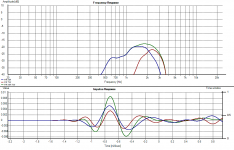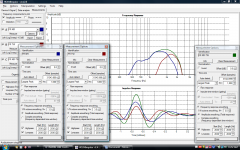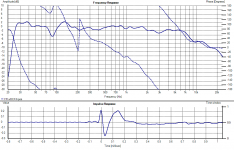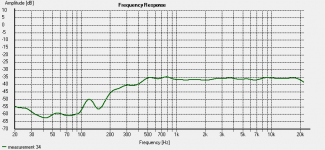I would be curious as to what others you have tried.😀An what do you see in HOLM Impulse better than those.Just discovered HOLMImpulse today, it's the best piece of measurement software that I have tried 😀
The following measurement is BMS 4552Nd on 18Sound XT1086 horn at 1 meter on-axis, with constant directivity eq, LR24 crossover at 1400Hz and group delay correction for approaching actual acoustic LR24 response (all done with DCX2496).
This is the only software I've used. I find it easy to use and figure out.
I did find one bug; I've taken measurements and then left leaving the software running. I came back 30 minutes later and "something" wouldn't output a signal. I had to reboot the PC. No idea what's causing this. I'm using a EMU1212.
This is the mid-tweeter measurement of a 3 way I've been working on.
I did find one bug; I've taken measurements and then left leaving the software running. I came back 30 minutes later and "something" wouldn't output a signal. I had to reboot the PC. No idea what's causing this. I'm using a EMU1212.
This is the mid-tweeter measurement of a 3 way I've been working on.
Attachments
can somebody shed some light on what's going on?
Your delays are wrong and the outputs from the speakers are not in phase at the crossover. Thus you have cancellations in the response. I seem to remember that impulse peaks should not be aligned when the frequency content of each impulse is very different - rather they should start to rise at the same time which is pretty difficult to judge visually. You might try looking at group delay instead to tweak in the alignment.
Boris You need to sychronize the impulse responses for each measurement. The software is using the "first peak" value as t = 0 and this is almost certainly NOT the case. You can synch to any one of the three, but the other two must use the same delay as the first one. You can do this in the software.
Member
Joined 2009
Boris You need to sychronize the impulse responses for each measurement.
I'm think I'm doing this already. I run a sweep on the tweeter (for better accuracy) and let HOLMImpulse automatically lock on the first positive peak. Then I use that peak as the "time zero" to make new measurements on each of the 3 drivers.
Then I see how far the first positive peaks are and I delay the appropriate number of samples in the dsp to align them. I can then move the microphone to a new location, lock the time zero again and take measurements which show all drivers aligned on the first peak.
Your delays are wrong and the outputs from the speakers are not in phase at the crossover. Thus you have cancellations in the response. I seem to remember that impulse peaks should not be aligned when the frequency content of each impulse is very different - rather they should start to rise at the same time which is pretty difficult to judge visually.
Thanks, John. I think I understand how the delay will shift the phase and cause a dip in the FR. I'm pretty sure my delays are wrong because I estimate 1cm to correspond to around 3.3samples at 48khz and I'm getting measurements that are different than the distance from the voice coils to the baffle plane. I'm assuming my measuring process is wrong.
You might try looking at group delay instead to tweak in the alignment.
I'm starting to get really frustrated with time alignment. It looks good on paper but I have a feeling it's only useful when drivers are stacked right in front of each other.
Boris, is the KX-system on the same computer as Holmimpulse?
Yes, kx-project and HOLMImpulse run together on the same computer. I don't see any problem with this, it's actually working out absolutely wonderful except my current mishaps with time-aligning but I attribute this to my scarce knowledge on the subject.
I'm pretty sure my delays are wrong because I estimate 1cm to correspond to around 3.3samples at 48khz and I'm getting measurements that are different than the distance from the voice coils to the baffle plane.
No, 1 sample at 48kHz would be about 0.72cm. So 3.3 samples would be 2.365 cm.
1 / (48000 samples / second) * (34400 cm / second) = 0.71667 cm / sample
So I'd guess you have your delays set wrong because of this. See if redoing them gets you closer. The voice coils will also not necessarily be the correct distance to set delays although they're probably in the ball park. Once you get the basic time alignment done, you might still have to tweak it around due to the phase shifts around the crossover frequencies. Looking at group delay can help with this, or you can just play with delay and look at the total frequency response.
Member
Joined 2009
yeah i'm burnt. 
you are right. 1 sample @ 48khz = 0.71667 cm.
i don't know where i was getting those numbers from. i need to stop thinking about this and go do something else before i lose it.
i'll read about group delay before i mess with this again.

you are right. 1 sample @ 48khz = 0.71667 cm.
i don't know where i was getting those numbers from. i need to stop thinking about this and go do something else before i lose it.
i'll read about group delay before i mess with this again.
I'm starting to get really frustrated with time alignment. It looks good on paper but I have a feeling it's only useful when drivers are stacked right in front of each other.
There is more than one approach to align, but in keeping with your original thought process maybe an example will help.
This is a LR24 MR/TW XO.
- Lock the time reference (per user guide)
- Measure the MR and TW drivers (I do this at the main listening position).
[We want the phase aligned at the XO freq. So:]
- Bandpass filter at, or closely around, the target XO freq. (per user guide)
[We can easily see the delay adjustment needed using the ms setting for the X scale.]
- Adjust the delay and repeat to confirm the proper alignment.
- Confirm in the freq response window the dip at the XO is filled.
Note that we can sum the MR/TW measurements with various offsets using "manipulation tab" to see the calculated impact on the freq response if we like. It is a good way to get a feel of the impact of various phase alignments.
Note that the unfiltered impulse peaks do not help with determining the proper alignment at XO.
pics of one of my efforts are attached.


There is an article on using group delay for alignment here: http://www.synaudcon.com/site/enewsletters/Spring07/nl072_subwooferalign.pdf
Member
Joined 2009
jtalden:
i was using a bandpass filter to simplify the IR plot at first but i didn't like the results. i don't think i had the band pass at the crossover however.
may i see your combined system FR with the phase plot?
johnPM:
thanks for the article!! it got me all excited again 🙂
do you know of any free software that can graph the group delay?
can it be done with a formula in excel?
i was using a bandpass filter to simplify the IR plot at first but i didn't like the results. i don't think i had the band pass at the crossover however.
may i see your combined system FR with the phase plot?
johnPM:
thanks for the article!! it got me all excited again 🙂
do you know of any free software that can graph the group delay?
can it be done with a formula in excel?
jtalden:
i was using a bandpass filter to simplify the IR plot at first but i didn't like the results. i don't think i had the band pass at the crossover however.
may i see your combined system FR with the phase plot?
Attached is my current front right speaker/sub combo using an avg of 6 mic positions within 1 m of my main listening position at 3 m.
There has been a minor XO adjustments since the earlier measurements, but the setup is very similar and still makes the point. The plot is 1/3 octave filtered.

I am using an EMU 0202 USB and have had similar problems. It happens pretty frequently. Like you, the only solution I have found is to reboot.
Terry
Terry
Member
Joined 2009
Attached is my current front right speaker/sub combo using an avg of 6 mic positions within 1 m of my main listening position at 3 m.
thanks jtalden! i'll give the bandpass on the crossover method another try.
ilardi, Mike Gergen your problem might be related to the Audio Stream dropping. See if restarting the stream in the Device/Signal page will fix it.
Hi Boris - I'm a bit brain fried at the moment so can't be of too much help - maybe later next week.
For alignment have a look at this PowerPoint show by Jean Michel Le Cleach'h
http://freerider.dyndns.org/anlage/LeCleach2.zip
Have a look at slides 48-53. This method works well.
For alignment have a look at this PowerPoint show by Jean Michel Le Cleach'h
http://freerider.dyndns.org/anlage/LeCleach2.zip
Have a look at slides 48-53. This method works well.
Eva, good to see you over here in the loudspeaker section. We don't see you over here very often.
The group delay is just the slope of the phase, so if you can export unwrapped phase you can calculate it easily. It think ARTA plots group delay.johnPM:
thanks for the article!! it got me all excited again 🙂
do you know of any free software that can graph the group delay?
can it be done with a formula in excel?
How do you calibrate for the software to reflect the true SPL/Amplitude levels?
Thanks
Ken
I would love to know that too, Im just starting my measurements.
I just tried to get my soundcard calibrated and when I try to save the calibration I get this...
Notebook running Vista, HOLM v1.4.2.0 sound card is the M-audio USB mobilepre.
An externally hosted image should be here but it was not working when we last tested it.
Notebook running Vista, HOLM v1.4.2.0 sound card is the M-audio USB mobilepre.
- Home
- Design & Build
- Software Tools
- HOLMImpulse: Measurements in practice
